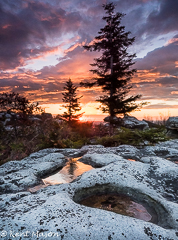| The Potomac Highlands |
Dolly Sods Wilderness and Scenic Area and the Bear Rocks PreserveThis is remote and rugged West Virginia mountain land with an often-severe quick changing climate. It is atop and just west of the Allegheny Front, the predominant ridge of the Appalachians and the "eastern" continental divide. This ridge has a rim of sandstone cliffs and giant rock outcropping with a 2000 to 3000 foot drop below. To the East there are breathtaking thirty-mile views where seven mountain ridges are visible on a clear day. Along the rim are stunted red spruce trees with flag formed limbs pointing to the east as a result of the almost constant and often-high velocity winds.
Large, striking and uniquely shaped white sandstone and quarts rocks are found throughout the Bear Rocks Preserve area. These wind and rain sculpted boulders rise up out of the heath barrens and tundra like areas. Erosion has carved bowl shaped cavities in many of the sandstone rocks and these cavities are often filled with water or ice and algae. In addition to the sculpted boulders are "rock streams" formed during glacial periods. The freeze thaw cycles heaved and split rock creating rock streams up to fifty foot wide and hundreds of fee long. Other rock patterns include polygons and circles. Large areas of heath barrens and tree sheltered peat bogs, more typical of Canada, are scattered along the west side of the Allegheny Front. The heath barrens consist of acid tolerant low growing plants such as blue berries, huckleberries, azaleas, mountain laurel, rhododendron trailing arbutus, mountain ash, and bear oak. Bogs, referred to by Indians as Muskegs (trembling earth) are waterlogged areas where thick moss and other plant life grow on the surface of the water. This unusual mountain bog plant life consists of goldthread, velvetleaf, blueberry, cranberry, 3-toothed cinquefoil, bog goldenrod, stiff club moss, closed gentian, chokeberry, wild raisin, and St. John's wort. Trails in the area are lined with green and gray mounds of reindeer moss. On the highest upland wind swept location (4000+ feet) are large open treeless areas referred to as grass balds. Covered with Mountain Oak grass and strewn with large boulders, these balds were once used for grazing stock by a pioneer German family named Dahle. Over time the entire area became known as Dolly Sods. Both Bear Rock Preserve and Dolly Sods Wilderness and Scenic Area are known for frequently severe ever-changing climate. Strong prevailing winds bring clouds from the west and while rising to clear the Allegheny Front, are cooled, causing mist and rain totaling over sixty inches a year. During the winter of 2003, 290 inches of snow fell in the area although 160 inches is more typical. The trees and shrubs become broken downward and gnarled along the ridge from the drying winds, the chilling rime frost and the heavy ice glazing and snow. On the broad ridge top where the climate is the severest, lush, dense vegetation moist red spruce and hemlock forest blanketed with ferns and mountain laurel and Rhododendron thickets a half to a quarter mile below give way stunted scattered trees, open heath land, and tundra plants left over from the ice ages. On the east side of the front the climate is dryer and there hardwood thrive sheltered by the ridge top. Although cool, damp weather dominates most of the year, on warm, sunny, summer day's temperatures can reach the low 80's. When entering this area, however, even in the summer, one must be prepared for frost. High winds and temperatures around 40 degrees at daybreak on the ridge can drop the wind chill to below freezing requiring winter clothing. By the same afternoon one can adequately dressed in a shirt. In a days hike one can travel through three climate zones. The Roaring Plains of Dolly Sods gives way to a climate that is less harsh at the lower elevations and there hardwood forests thrives. The Red Creek drains the Sods, the highest tundra valley in the USA East of the Rocky Mountains. This is truly a wild wilderness presenting a great variety of topography and habitat with very distinctive features waiting to be photographed. For the photographer, it's an inspirational experience to be at Dolly Sods and Bear Rocks Preserves. See also: How Do I Achieve Deep Rich Colors in My Photography |
| Updated 2-apr-15 Contents copyright © 2008-2014 WVphotographs.com, All Rights Reserved |


